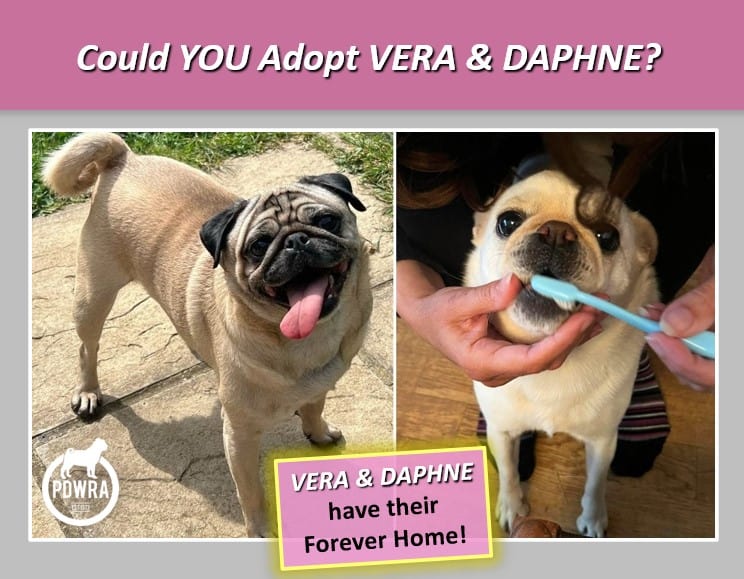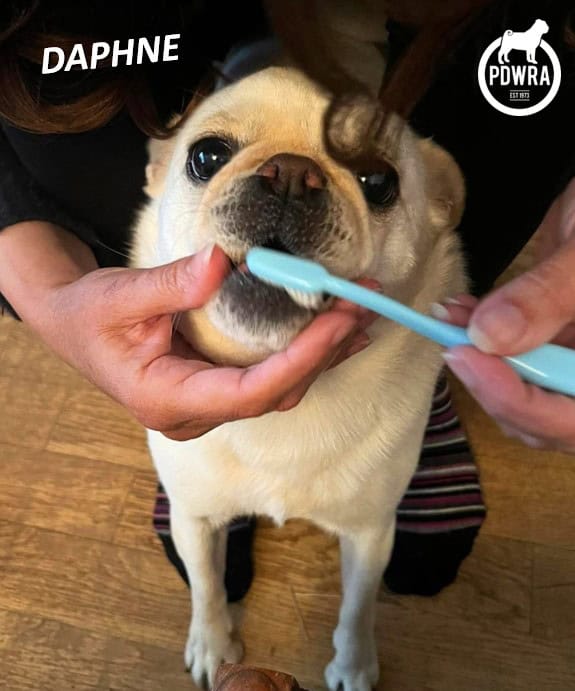
by Yasmin | 4 Jun, 2025 | Blog, News, Volunteering, Fundraising
💖This week is National Volunteers’ Week, and the perfect time for PDWRA to celebrate its ongoing gratitude to ALL Volunteers! 💖
🤗 THANK YOU ALL! 🤗

We could not help Pugs in Need without the voluntary contributions each & everyone makes with their skills, experience & time. Our costs are covered solely by public donations & fundraising!
Volunteers contribute to all stages that enable rehoming, from Trustees in Management to the regional rehoming co-ordinators (Voluntary Area Co-ordinators – VACs), who facilitate local pug rescue/surrenders, health & welfare assessments, rehabilitation where needed, and organise the onward placements to the pugs’ best-suited homes.

This is where regional, local, Home-checkers & Transporters are essential, volunteering their time to achieve the goal of rehoming Pugs in Need safely and securely.
Additionally, to support these operations, are the dedicated small teams for the PDWRA Facebook Mega Auction group’s Fundraising, plus Communications, managing PDWRA’s Website and Social Media, keeping everyone informed & updated.

******
Here’s a recent, wonderful example of Volunteers going the extra mile to get pugs along their life’s journey to their Forever Homes. In this case, Wilfred & Michael reaching their respective Forever Homes.

Read the full story with more photographs, here: https://pugwelfare-rescue.org.uk/thank-you-pdwra-volunteers-transporters/

******
Volunteers are welcome from all parts of the country.
We are grateful for the time freely given by our Volunteer Transporters, as well as Home-Checkers; Pugs could not join their respective Fosterers or Adopters without them!
To find out more about Volunteering to Transport or to Home-check or Foster, please see our webpage: https://pugwelfare-rescue.org.uk/volunteering-for-pdwra/

For other dedicated Voluntary roles to consider. See our Vacancies at: https://pugwelfare-rescue.org.uk/volunteer-opportunities-at-pdwra/


by Yasmin | 2 Jun, 2025 | Pug Home Appeal, Blog, Rescue Stories
👏 * GREAT NEWS UPDATE: Ray & Carla have found their Perfect Forever Home, together of course! * 👏
**********
RAYMOND (RAY) & CARLA.
This Brother and Sister pair, are 8 years old and very devoted to each other. Ray more so than Carla. He’s a sensitive soul and uneasy if she’s not around.
Both were quite lively on first arrival with their fosterer but have calmed down now they are in a routine and regularly walked.
Carla is a cuddly affectionate pug and loves the company of humans. Happy and calm around other dogs and accepting of cats. She is friendly and inquisitive on meeting people, though not tested on children.
Carla is to undergo surgery to improve her breathing. Once recovered, she will be able to enjoy life to the full. Both are neutered.

Ray is a gentle pug who loves to be stroked, he can suffer from anxiety and is at his happiest in the company of humans and with Carla by his side. Almost totally blind in one eye, he has adapted extremely well and this does not hinder his ability to enjoy the world around him.
He needs regular application of eye drops to ensure the eye is properly lubricated. Ray’s very sociable and gentle with other dogs, he can be friendly but rather shy on first meeting new people.
He gets on well with cats but will try to steal their food!
Ray prefers to walk in more peaceful settings away from traffic noise.
Both will thrive in a peaceful and calm household with love and affection. They do suffer with separation anxiety which will need to be worked on. A home with children over 10 years is advised.

Please also ensure you have read PDWRA’s Guidelines & Conditions for Adopting, at: https://pugwelfare-rescue.org.uk/adopting-a-pug/
If you have any specific questions about Ray & Carla, or your application for them, please email Jackie at: se@nullpugwelfare-rescue.org.uk
Afterwards, do check your email spam/junk or deleted folders, in case any new mails from us aren’t recognised as safe-senders.
** We offer A £100 discount (£50 per pug), when adopting a Bonded-Pair of Pugs! **
Thank you!
******
To see the difference adoption can make to your life and theirs, see some of our heart-warming Rescue & Adoption Stories for Bonded-Pairs at:
https://pugwelfare-rescue.org.uk/perfect-pairs/


by Yasmin | 2 Jun, 2025 | Pug Home Appeal, Blog, Rescue Stories
👏 ** HAPPY NEWS UPDATE: Daphne & Vera have their Perfect Home Together! ** 👏
*******
DAPHNE & VERA
Five years old, and both spayed, Daphne and Vera are a devoted bonded-pair of pugs.
Vera is the more outgoing of the two, Daphne prefers to just chill out with her humans.
Both are in good health with Daphne recovering from recent dental surgery. She will be back to normal by the time they have their Forever Home to move to.

Daphne has a sweet, friendly nature, very well behaved on and off the lead. She is very calm when meeting children and is happy for them to stroke her gently. She can be startled by loud noises though, in and outside the home.
She loves her walks but you must allow for plenty of sniffing time, as she likes to take her time!

Vera is not so quick to trust people, she likes to get to know them. Give her time and space and she will make her own choices.
She is not happy being approached by strangers trying to pet her, and for this reason, care should be taken when out walking as she suffers from fear aggression and may nip the unwary. This may be partly due to a slight sight impairment as she can also be taken by surprise in dim light.
Toys are her absolute joy and she will play all day.
Both are happy living with other dogs and cats, but would be better suited with children over 10 years who can respect Vera’s boundaries.
Please also ensure you have read PDWRA’s Guidelines & Conditions for Adopting, at: https://pugwelfare-rescue.org.uk/adopting-a-pug/
If you have any specific questions about Daphne & Vera or your application, please email Jackie at: se@nullpugwelfare-rescue.org.uk
Afterwards, do check your email spam/junk or deleted folders, in case any new mails from us aren’t recognised as safe-senders.
** We offer A £100 discount (£50 per pug), when adopting a Bonded-Pair of Pugs! **
Thank you!
******
To see the difference adoption can make to your life and theirs, see some of our heart-warming Rescue & Adoption Stories for Bonded-Pairs at:
https://pugwelfare-rescue.org.uk/perfect-pairs/


by Yasmin | 2 Jun, 2025 | Pug Home Appeal, Blog, Rescue Stories
👏 ** WONDERFUL NEWS UPDATE: Cleo & Elmo have already found their Perfect forever Home! ** 👏
**********
ORIGINAL APPEAL:
Cleo and Elmo are 8 year old siblings, super-bonded to each other.
They are used to living with other dogs but are just as happy in each other’s company. They are both neutered.
Cleo has one eye, the other must be kept lubricated to ensure it remains healthy. She is easy going and gets on with everyone, the more confident of the pair. She has had surgery on both hind legs for luxating patella but this does not hinder her mobility. Care should be taken however not to over walk her beyond her comfort zone.

Elmo is more dependant on Cleo and does not like to be parted from her. He’s easy going and very calm but is anxious if not within sight of Cleo.

Both love to sit with their humans and enjoy cuddles on the sofa. They mix well with other dogs and are used to children. Not tested on cats. An easy-going pair who should fit in with most households providing they have plenty of opportunities for cuddles, and are walked within their capabilities.
These charming siblings will bring a lot of love and devoted companionship to anyone’s home.
Please also ensure you have also read PDWRA’s Guidelines & Conditions for Adopting, at: https://pugwelfare-rescue.org.uk/adopting-a-pug/
** Don’t Forget – We offer A £100 discount (£50 per pug), when adopting a Bonded-Pair of Pugs! **

Thank you!
******
To see the difference adoption can make to your life and theirs, see some of our heart-warming Rescue & Adoption Stories for Bonded-Pairs at:
https://pugwelfare-rescue.org.uk/perfect-pairs/


by Yasmin | 28 May, 2025 | Pug Home Appeal, Blog, Rescue Stories
👏 ** GREAT NEWS, Dec has his Forever Home lined up, following an amazing response in Applications for him, Lucky Boy! ** 👏
***
APPEAL INFORMATION:
This is two year old Dec who’s looking for his adoptive home!
He’s an affectionate boy who enjoys a fuss being made of him, as well as companionship.
🐾 Dec is very active and enjoys long walks.
🐾 He can live with kind, respectful children of five plus years.
🐾 Dec can live as an only dog, or potentially with another compatible dog who will appreciate his youthful excitability.
🐾 He will need to be fed separately, as is very food-orientated.
🐾 Unfortunately, Dec does not like cats!

Dec is neutered, vaccinated and in good health.
His housetraining is work in progress. Walking regularly helps and he really loves his walks.
Patience and routine is a must for him.
Dec responds to basic commands though training to wait for treats for example will need work on! 😄
******
Dec responds to basic commands though training to wait for treats for example, needs work on!
He can be nervous/scared if unsure, or hears loud noises or someone approaches suddenly though can be comfortably examined by a vet.
This delightful young boy will bring a lot of joy and life to any home!

Thank You!
If you have any specific questions about Dec, or your application, please email Jane & Cara at: central@nullpugwelfare-rescue.org.uk
Please ensure you have read PDWRA’s Guidelines & Conditions for Adopting, at: https://pugwelfare-rescue.org.uk/adopting-a-pug/
******
Please also take a look at our sample of happy, successful Rescue & Adoption Stories, to see the mutual joy that adopting brings, at:
https://pugwelfare-rescue.org.uk/category/rescue-stories/

























